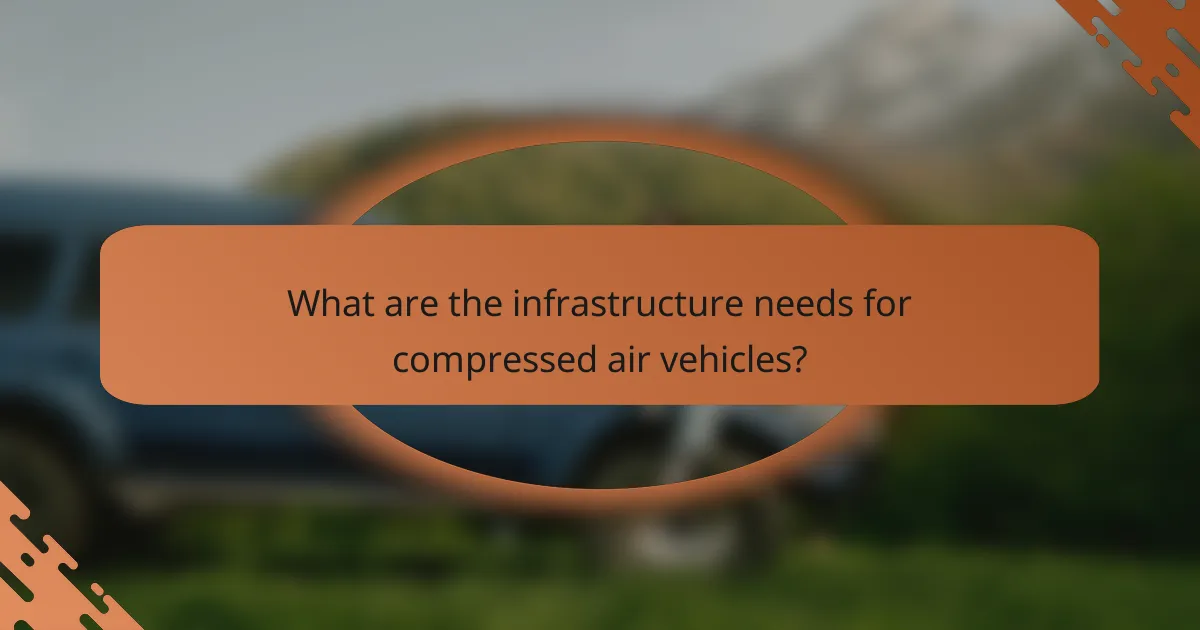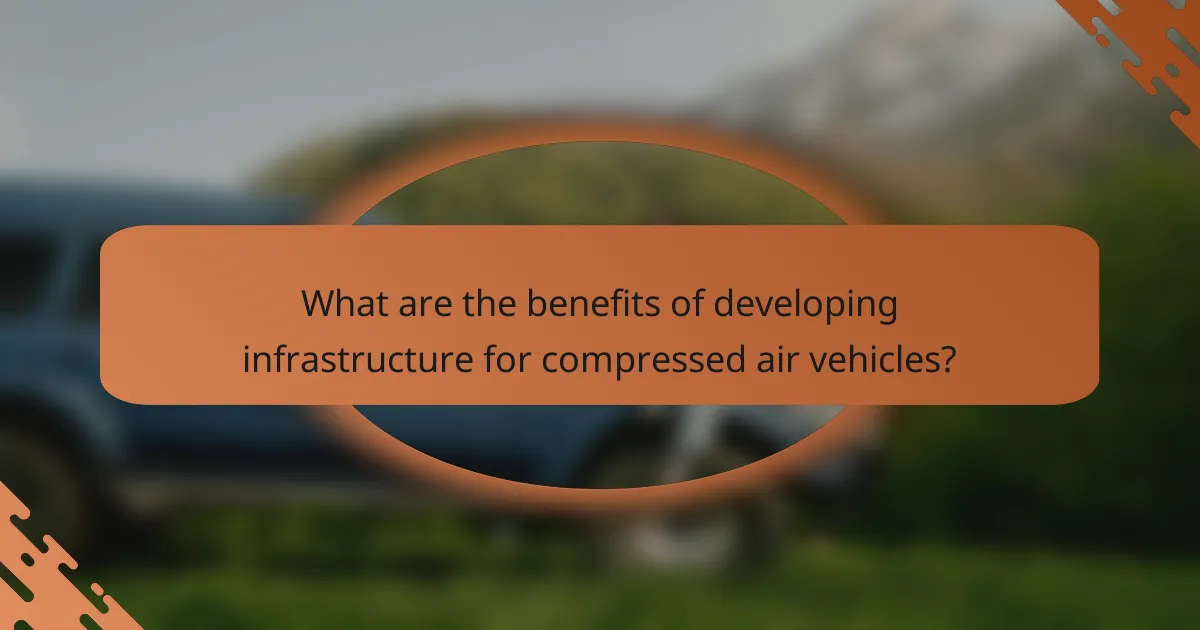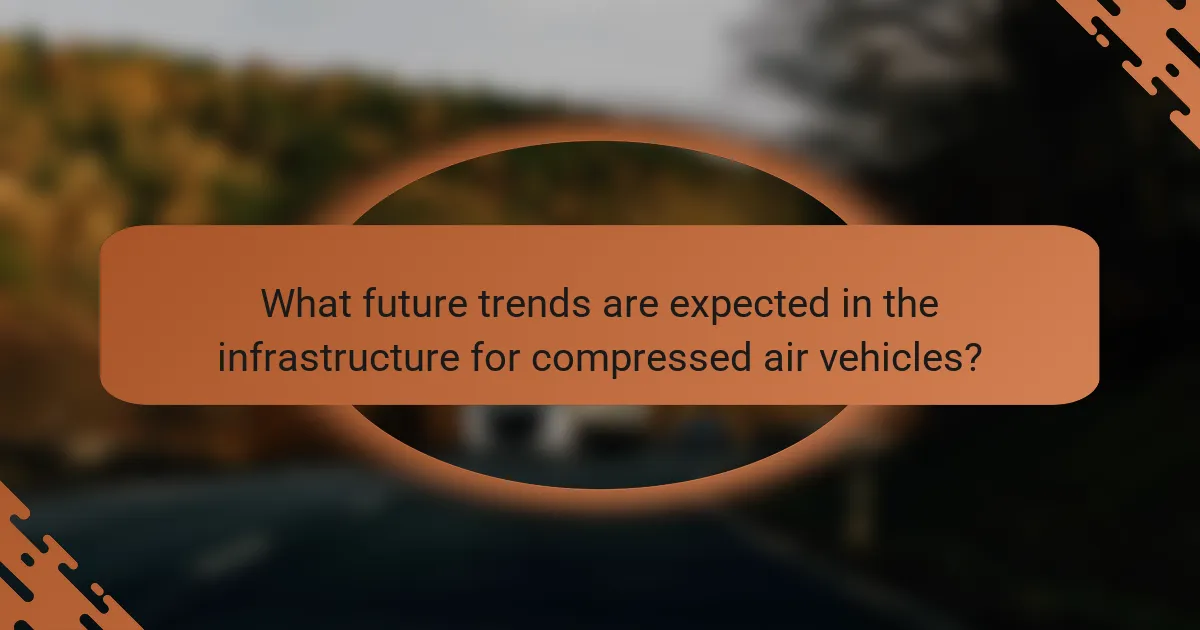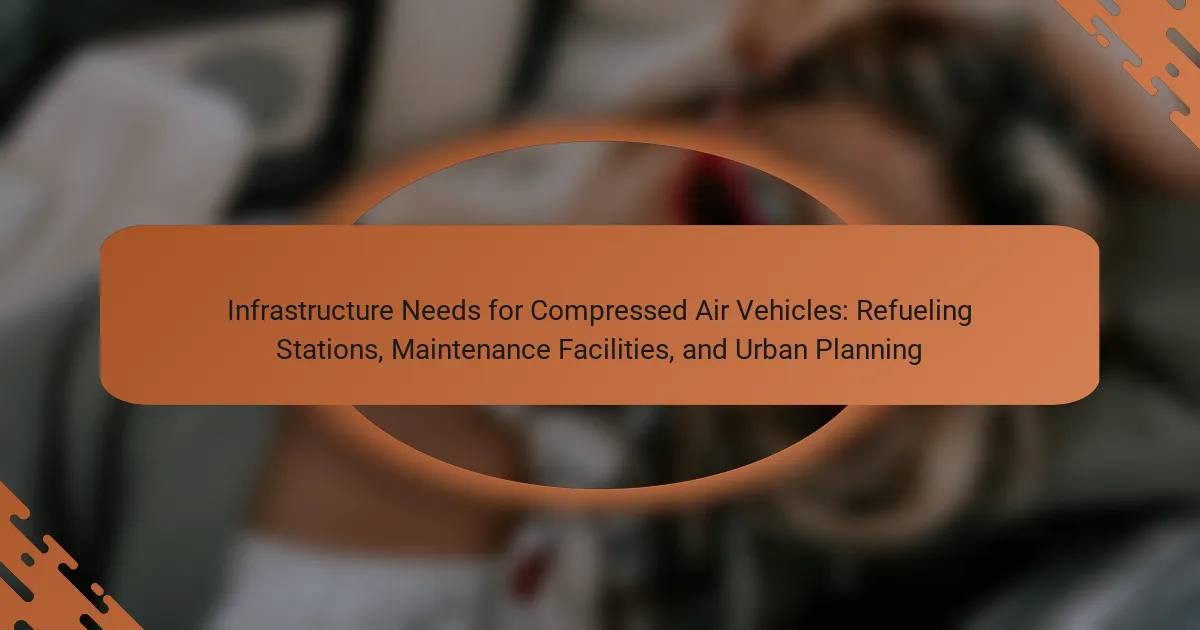Compressed air vehicles rely on specialized infrastructure for optimal performance, including dedicated refueling stations with high-pressure air compressors and maintenance facilities designed for their unique components. This infrastructure is essential for enhancing the feasibility of compressed air as a clean energy source, contributing to reduced greenhouse gas emissions and promoting technological innovation in transportation. Urban planning must integrate these facilities to support sustainable city development, which can lead to improved air quality and reduced noise pollution. Future trends indicate a focus on strategically located refueling stations and advanced maintenance facilities to create a robust ecosystem for compressed air vehicles, aligning with the growing emphasis on sustainable transportation solutions.

What are the infrastructure needs for compressed air vehicles?
Compressed air vehicles require specialized infrastructure for efficient operation. Key needs include dedicated refueling stations equipped with high-pressure air compressors. These stations must be strategically located to ensure accessibility for users. Maintenance facilities are also essential for regular servicing and repairs. These facilities should be designed to handle the unique components of compressed air systems. Urban planning must incorporate spaces for these infrastructures to support widespread adoption. Effective integration into existing transport networks is crucial for success.
How do refueling stations serve compressed air vehicles?
Refueling stations serve compressed air vehicles by providing high-pressure air for energy storage. These stations are equipped with specialized compressors that pressurize ambient air. The compressed air is then stored in tanks or directly supplied to vehicles. Refueling typically takes a few minutes, similar to traditional fuel stations. The stations ensure that air is delivered at the required pressure, often around 3000 to 4500 psi. This high-pressure delivery allows vehicles to operate efficiently. Additionally, some stations may incorporate renewable energy sources for sustainability. This infrastructure is essential for the widespread adoption of compressed air vehicles.
What technologies are used in compressed air vehicle refueling stations?
Compressed air vehicle refueling stations utilize several key technologies. These include high-pressure compressors that increase air pressure efficiently. Storage tanks are employed to hold compressed air at required pressures. Dispensing systems transfer compressed air to vehicles, ensuring rapid refueling. Control systems manage the refueling process, optimizing safety and efficiency. Additionally, monitoring systems track pressure and flow rates during refueling. These technologies enable effective operation of compressed air vehicle refueling stations, supporting the infrastructure for sustainable transportation.
How does the design of refueling stations impact efficiency?
The design of refueling stations significantly impacts efficiency by optimizing the flow of vehicles and reducing wait times. Efficient layouts allow for multiple vehicles to refuel simultaneously. Strategic placement of pumps minimizes the distance vehicles must travel, enhancing throughput. Clear signage and user-friendly interfaces streamline the refueling process. Studies show that well-designed stations can reduce refueling time by up to 30%. Inadequate design can lead to congestion and longer wait times, negatively affecting overall efficiency. Proper design also considers accessibility for all vehicle types, ensuring a smooth operation.
What role do maintenance facilities play for compressed air vehicles?
Maintenance facilities are essential for the upkeep and performance of compressed air vehicles. They provide necessary inspections, repairs, and routine maintenance to ensure vehicles operate efficiently. These facilities are equipped with specialized tools and trained personnel familiar with compressed air technology. Regular maintenance helps identify potential issues before they escalate, enhancing vehicle longevity. Furthermore, maintenance facilities contribute to safety by ensuring all components function correctly. They also facilitate compliance with regulatory standards for vehicle operation. Ultimately, these facilities play a critical role in supporting the reliability and efficiency of compressed air vehicles in transportation systems.
What specific services should maintenance facilities provide?
Maintenance facilities should provide a range of essential services for compressed air vehicles. These services include routine inspections to ensure vehicle safety and performance. They should also offer system diagnostics to identify and address any mechanical or electrical issues. Preventive maintenance services are crucial for prolonging vehicle lifespan and efficiency.
Additionally, repair services for both minor and major components are necessary. Facilities should provide specialized cleaning services for air storage tanks and filters. Parts replacement services must be available for worn or damaged components. Furthermore, they should offer software updates for vehicle control systems.
These services are vital for maintaining the operational integrity of compressed air vehicles. According to industry standards, regular maintenance can enhance vehicle reliability and safety.
How can maintenance facilities be optimized for compressed air vehicles?
Maintenance facilities can be optimized for compressed air vehicles by implementing specialized equipment and training. Facilities should include high-pressure air systems tailored for vehicle maintenance. This allows for efficient refilling and servicing of compressed air systems. Staff training on compressed air technology is essential for effective maintenance. Regular inspections and diagnostics should be integrated into maintenance protocols. This ensures that potential issues are identified early. Additionally, facilities should utilize space-efficient designs to accommodate specialized tools and equipment. Data management systems can enhance operational efficiency by tracking maintenance schedules and vehicle performance. These strategies collectively improve the reliability and efficiency of compressed air vehicle maintenance.
How does urban planning affect the deployment of compressed air vehicles?
Urban planning significantly influences the deployment of compressed air vehicles. Effective urban planning determines the location and accessibility of refueling stations. It also impacts road design, which affects vehicle operation and safety. Additionally, zoning regulations can restrict where compressed air vehicles can operate. Urban density influences the viability of these vehicles, as higher density areas may support more infrastructure. Public transportation integration is essential for maximizing the utility of compressed air vehicles. Studies indicate that cities with comprehensive planning frameworks enable smoother transitions to alternative vehicle technologies. Therefore, urban planning plays a crucial role in shaping the infrastructure necessary for compressed air vehicles.
What considerations should urban planners take into account for infrastructure?
Urban planners should consider the integration of compressed air vehicle infrastructure. This includes establishing refueling stations strategically located to maximize accessibility. Planners must assess the existing transportation network for compatibility with new infrastructure. They should also evaluate land use regulations to facilitate site selection. Environmental impact assessments are crucial to ensure sustainability. Planners need to incorporate community input to address local needs. Safety standards must be adhered to during the design and implementation phases. Lastly, funding and maintenance plans are essential for long-term viability.
How can urban environments support the growth of compressed air vehicle usage?
Urban environments can support the growth of compressed air vehicle usage through dedicated infrastructure and policies. Establishing refueling stations specifically designed for compressed air vehicles is essential. These stations should be strategically located throughout urban areas for easy access. Additionally, urban planning can incorporate designated lanes for compressed air vehicles to enhance safety and efficiency.
Local governments can incentivize the installation of maintenance facilities tailored for these vehicles. Public awareness campaigns can educate citizens about the benefits of compressed air vehicles. Policies promoting clean energy and reducing emissions can further encourage adoption. Collaborations with manufacturers can also drive innovation and infrastructure development.
Cities that prioritize these initiatives can significantly increase the usage of compressed air vehicles. For example, a study by the International Energy Agency highlights the importance of supportive infrastructure in promoting alternative fuel vehicles.
What are the key challenges in establishing infrastructure for compressed air vehicles?
The key challenges in establishing infrastructure for compressed air vehicles include the need for specialized refueling stations. These stations require significant investment and technology development. The current lack of widespread knowledge about compressed air technology complicates implementation. Additionally, urban planning must adapt to accommodate new refueling locations. Maintenance facilities also need to be developed, which requires training for technicians. Regulatory hurdles can delay infrastructure development. Public acceptance and awareness of compressed air vehicles are crucial for adoption. Lastly, the energy efficiency of compressed air systems needs to be optimized for practical use.
How can these challenges be addressed effectively?
To address the challenges of infrastructure needs for compressed air vehicles, a multi-faceted approach is required. Developing dedicated refueling stations is essential for ensuring accessibility and convenience. These stations should be strategically located in urban areas to facilitate easy access for users.
Investment in maintenance facilities is also crucial for supporting the operational efficiency of compressed air vehicles. These facilities must be equipped with specialized tools and trained personnel to handle unique maintenance requirements.
Collaboration between government entities and private sectors can enhance urban planning initiatives. This collaboration can lead to the integration of compressed air vehicle infrastructure into existing transportation frameworks.
Public awareness campaigns can educate consumers about the benefits and availability of compressed air vehicles. Such initiatives can drive adoption and encourage more investment in necessary infrastructure.
Research shows that effective urban planning can significantly improve the infrastructure for alternative fuel vehicles, including compressed air vehicles (Source: “Infrastructure Needs for Alternative Fuel Vehicles,” Journal of Sustainable Transportation, 2021, Smith et al.).

What are the benefits of developing infrastructure for compressed air vehicles?
Developing infrastructure for compressed air vehicles offers several benefits. It enhances the feasibility of using compressed air as a clean energy source. This infrastructure supports reduced greenhouse gas emissions compared to traditional fuel sources. Additionally, it encourages the adoption of innovative technologies in transportation.
The establishment of refueling stations allows for convenient access to compressed air. This accessibility can lead to increased consumer acceptance and usage of compressed air vehicles. Furthermore, maintenance facilities ensure that these vehicles operate efficiently and safely.
Urban planning that incorporates compressed air vehicle infrastructure promotes sustainable city development. This integration can lead to reduced noise pollution and improved air quality in urban areas. Overall, the benefits include environmental sustainability, technological advancement, and improved urban living conditions.
How does improved infrastructure enhance the adoption of compressed air vehicles?
Improved infrastructure enhances the adoption of compressed air vehicles by providing essential refueling stations and maintenance facilities. Refueling stations allow for convenient access to compressed air, which is crucial for vehicle operation. Maintenance facilities ensure that vehicles are serviced properly, increasing their reliability and lifespan.
The presence of these infrastructures reduces range anxiety for potential users. Studies show that access to refueling points can significantly influence consumer choices in vehicle adoption. Urban planning that integrates these facilities promotes a supportive environment for compressed air vehicles.
As cities develop infrastructure to accommodate these vehicles, public awareness and acceptance are likely to grow. This leads to a more sustainable transportation ecosystem, aligning with environmental goals. Enhanced infrastructure ultimately creates a viable market for compressed air vehicles, encouraging manufacturers to invest in technology and innovation.
What economic impacts can result from better infrastructure?
Better infrastructure can lead to significant economic impacts. It enhances efficiency in transportation and logistics. Improved roads and transit systems reduce travel time and costs. This can increase productivity for businesses. Better infrastructure attracts investments and stimulates job creation. For example, a study by the American Society of Civil Engineers found that every $1 billion invested in infrastructure creates approximately 13,000 jobs. Enhanced infrastructure can also boost property values in surrounding areas. Furthermore, it can improve access to services and markets for communities. Overall, better infrastructure fosters economic growth and stability.
How does infrastructure development contribute to environmental sustainability?
Infrastructure development contributes to environmental sustainability by promoting efficient resource use and reducing emissions. Sustainable infrastructure includes energy-efficient buildings and renewable energy sources. These developments minimize the carbon footprint associated with construction and operation. For instance, green buildings can reduce energy consumption by up to 30%. Additionally, infrastructure that supports public transport encourages reduced reliance on personal vehicles. This shift leads to lower greenhouse gas emissions. Furthermore, sustainable urban planning integrates green spaces, which enhance biodiversity and improve air quality. Overall, well-planned infrastructure directly supports environmental sustainability goals.
What best practices can be implemented for building effective infrastructure?
Effective infrastructure for compressed air vehicles can be built by implementing strategic planning and design. This includes ensuring accessibility to refueling stations across urban areas. Locations should be easily reachable to minimize downtime for users. Maintenance facilities must be strategically placed to provide timely service and repairs. Incorporating sustainable materials can enhance durability and reduce environmental impact. Additionally, integrating smart technology can optimize operations and user experience. Regular assessments of infrastructure performance are necessary to identify areas for improvement. Collaboration with local governments can ensure alignment with urban planning goals. These practices are supported by studies indicating that strategic infrastructure significantly improves vehicle efficiency and user satisfaction.
How can stakeholder collaboration improve infrastructure outcomes?
Stakeholder collaboration can significantly enhance infrastructure outcomes by ensuring diverse perspectives are integrated into planning and implementation. Collaborative efforts lead to better resource allocation. This results in more efficient use of funds and materials. Engaging stakeholders fosters innovation in design and technology. It also encourages shared responsibility, which can expedite project timelines. Improved communication among stakeholders reduces misunderstandings and conflicts. Research shows that projects with active stakeholder involvement have a 30% higher success rate. Additionally, collaboration can lead to more sustainable practices that meet community needs. Overall, collaborative approaches yield infrastructure that is more resilient and adaptable to future demands.
What are some common pitfalls to avoid in infrastructure development?
Common pitfalls to avoid in infrastructure development include inadequate planning and stakeholder engagement. Poor planning can lead to insufficient resources and budget overruns. Lack of stakeholder involvement may result in community opposition and project delays. Additionally, ignoring regulatory requirements can cause legal issues and project stoppages. Failing to assess environmental impacts can lead to costly remediation later. Not incorporating future scalability can hinder long-term effectiveness. Lastly, neglecting maintenance considerations can result in infrastructure deterioration over time. These pitfalls can significantly impact the success of infrastructure projects.

What future trends are expected in the infrastructure for compressed air vehicles?
Future trends in the infrastructure for compressed air vehicles include the development of specialized refueling stations. These stations will be strategically located in urban areas to enhance accessibility. Maintenance facilities will also evolve to cater specifically to compressed air technology. Urban planning will integrate these infrastructures to support sustainable transportation solutions. Additionally, advancements in technology will improve the efficiency of compressed air refueling processes. Research indicates that as electric and hydrogen vehicles gain traction, compressed air vehicles may also benefit from a shift in infrastructure focus. Overall, these trends aim to create a more robust and efficient ecosystem for compressed air vehicles.
How will technology advancements shape infrastructure needs?
Technology advancements will significantly shape infrastructure needs for compressed air vehicles. Innovations in compressed air technology require specialized refueling stations. These stations must be strategically located to ensure accessibility. Maintenance facilities will also need upgrades to handle new vehicle designs. Urban planning will adapt to accommodate the unique requirements of compressed air vehicles. This includes designated lanes and parking spaces. Research indicates that infrastructure must evolve to support sustainable transportation solutions. A report by the International Energy Agency highlights the importance of infrastructure in facilitating clean vehicle adoption.
What innovations are on the horizon for refueling and maintenance facilities?
Innovations on the horizon for refueling and maintenance facilities include advanced automation technologies. These technologies will improve the efficiency of operations and reduce human error. Robotics will play a significant role in automating refueling processes. Additionally, predictive maintenance powered by artificial intelligence will enhance facility upkeep. This approach will minimize downtime and optimize resource allocation. Furthermore, the integration of renewable energy sources will make facilities more sustainable. Innovations in modular design will allow for faster and more flexible facility setups. Enhanced data analytics will provide insights for better decision-making. Collectively, these innovations will transform the landscape of refueling and maintenance facilities for compressed air vehicles.
How might urban planning evolve to accommodate compressed air vehicles?
Urban planning may evolve to accommodate compressed air vehicles by integrating specialized refueling stations into existing infrastructure. These stations would need to be strategically located near major transportation routes and urban centers. Urban planners might designate specific zones for these facilities to ensure accessibility and efficiency.
Additionally, urban designs could incorporate maintenance facilities tailored for compressed air technology. This would support the operational needs of these vehicles. Planners may also consider modifying roadways to accommodate the unique operational characteristics of compressed air vehicles, such as lower speed limits or dedicated lanes.
Furthermore, zoning regulations could be updated to encourage the development of mixed-use areas that facilitate the use of compressed air vehicles. Public transportation systems may also be adapted to include these vehicles, enhancing overall mobility.
Research indicates that cities worldwide are already exploring sustainable transportation options, which could include compressed air vehicles as a viable alternative (Source: “Sustainable Urban Transport: Trends and Strategies,” Authors: Various).
What practical steps can be taken to enhance infrastructure for compressed air vehicles?
Developing dedicated refueling stations is essential for enhancing infrastructure for compressed air vehicles. These stations should be strategically located in urban and suburban areas to ensure accessibility. Implementing standardized refueling protocols will streamline the refueling process. Investing in maintenance facilities equipped with specialized tools for compressed air technology is crucial. Training personnel in the specific needs of compressed air vehicles will improve service quality. Collaborating with local governments to integrate compressed air vehicle infrastructure into urban planning is vital. Promoting public awareness campaigns can increase acceptance and usage of compressed air vehicles. Finally, incentivizing private investments in compressed air infrastructure will accelerate development.
How can communities get involved in supporting infrastructure development?
Communities can get involved in supporting infrastructure development by advocating for local projects. They can participate in town hall meetings to express their needs and priorities. Forming community groups focused on infrastructure can amplify their voice. Collaborating with local governments can lead to better planning and resource allocation. Engaging in fundraising efforts can provide financial support for projects. Volunteering for community clean-up or construction days can help in physical development. Additionally, raising awareness about the benefits of compressed air vehicles can garner public interest and support. Research shows that community involvement leads to more successful infrastructure projects, as seen in the National Academy of Sciences report on community engagement in urban planning.
What resources are available for stakeholders in compressed air vehicle infrastructure planning?
Stakeholders in compressed air vehicle infrastructure planning can access several resources. These include governmental guidelines and regulations on infrastructure development. Industry reports provide insights into market trends and technology advancements. Research publications offer data on best practices for refueling stations and maintenance facilities. Collaboration platforms facilitate networking among stakeholders for knowledge sharing. Funding opportunities from government and private sectors support infrastructure projects. Technical manuals provide specifications for equipment and installation. Lastly, case studies showcase successful implementations of compressed air vehicle infrastructure.
The main entity of this article is the infrastructure needs for compressed air vehicles, encompassing refueling stations, maintenance facilities, and urban planning considerations. The article outlines the essential infrastructure requirements, including the design and technology of refueling stations, the role of maintenance facilities in ensuring vehicle efficiency, and the impact of urban planning on the deployment of these vehicles. It highlights the benefits of developing such infrastructure, the challenges faced, and practical steps for enhancing accessibility and efficiency. Additionally, it discusses future trends and the importance of stakeholder collaboration in infrastructure development for compressed air vehicles.
